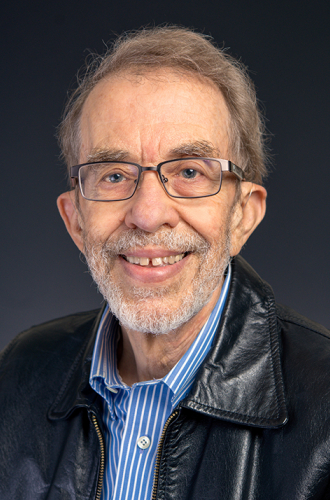-

-

-
Harry L Swinney
Professor Emeritus
Department of Physics
Sid W. Richardson Foundation Regents Chair in Physics #3 (Emeritus)Nonlinear dynamics; chaos; pattern formation; dynamics of internal gravity waves in the oceans and of growing bacterial colonies.-
Ph.D., Johns Hopkins University, 1968
Research Interests
Nonlinear dynamics; chaos; pattern formation; dynamics of internal gravity waves in the oceans and of growing bacterial colonies.
I grew up planning to become a civil engineer like my father and grandfather; but after taking introductory physics in college, I switched from engineering to physics. From my high school days, I have always liked small tabletop lab projects. For my senior honors project in college my advisor told me no space was available except in an unused coal storage bin in the basement of the Physics building. With his encouragement, I built an apparatus there to study exploding metal wires. The spectrum of the light emitted by the exploding wires was obtained with a spectrometer I built using a cheap diffraction grating.My research has always involved small-scale experiments where a single person (say, a student or postdoc) can design and build the apparatus and collect and interpret the data. The laboratory results can be compared with theory, if available, and/or the researcher can develop and numerically simulate a mathematical model.
My research group studies instabilities, chaos, pattern formation, and turbulence in systems driven away from equilibrium by the imposition of gradients in temperature, velocity, pressure, concentration, etc. We search for an understanding of dynamical behavior that is similar in diverse systems. We have studied the dynamics of patterns formed in a fluid contained between concentric rotating cylinders; chaos, spatial patterns, and strange attractors in oscillating chemical reactions; a laboratory model of Jupiter’s Great Red Spot; a laboratory model of the atmospheric “blocking” phenomenon; patterns and turbulence in convecting fluids; growth of metallic fractal clusters in electrodeposition; buckling of thin sheets (garbage bags, leaves of plants); and patterns and shock waves in vibrating and flowing sand.
My current research concerns three areas:
(1) Gravity waves like those that are internal to the atmosphere, oceans, and other fluids where the density decreases with height. We study these internal waves in density stratified fluids in laboratory tanks where the parameters are chosen to mimic ocean conditions. We would like to understand the complex nonlinear mechanism that drives ocean currents (e.g. Gulf Stream), which have a major affect on the Earth’s climate.
(2) The dynamics of patterns formed by two growing bacterial colonies that are near one another. We find that competing colonies grown from the same original culture can compete and, surprisingly, kill one another. We would like to understand how it is to the advantage of the species for siblings to kill one another. This research, conducted in collaboration with biologists, has revealed a new toxin specific to the particular type of bacteria we are studying, but there indications that similar toxins may be produced by other bacteria.
(3) Interfacial patterns formed between two immiscible fluids such as water and oil. Fingers of water can penetrate into the oil, as is the case when oil is pumped from an underground reservoir (then much of the oil is left behind!). We attack this mathematically difficult “viscous fingering” problem in lab experiments and in numerical simulations of models. The goal is to find general principles (rules) governing the selection of finger sizes and the angles between fingers.
-
Publications:
Swinney has more than 250 publications, which have been cited more than 16,000 times (ISI Web
of Science); 57 of the papers have been cited 57 or more times.
-
Swinney was elected to the National Academy of Sciences in 1992. He is a Fellow of the American
Physical Society, the American Association for the Advancement of Science, the American
Academy of Arts and Sciences, and the Society of Industrial and Applied Mathematics. In 1967 he
was awarded a National Space Club Fellowship and a National Science Foundation Fellowship. He
was a John Simon Guggenheim Foundation Fellow in 1983-84. In 1985 he became the founding
director of the Center for Nonlinear Dynamics (chaos.utexas.edu), a research center at The
University of Texas at Austin. He was inducted into Johns Hopkins Society of Scholars(1984), and
he received the 1987 Career Research Excellence Award from the University of Texas at Austin. He
was awarded honorary doctorates by Rhodes College (2002), Hebrew University of Jerusalem
(2008), and the University of Buenos Aires (2010).
-














